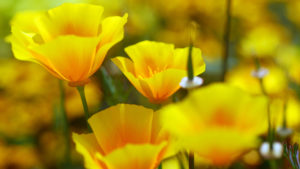Plant selection for lining your driveway begins with the consideration of many factors. Many elements are the same for any planting project, such as soil density, light exposure, and drainage considerations. Additionally, others may include the size of the driveway and the size of the area plants will be incorporated.
Soil Density
To create a thriving environment for your drought-tolerant plants, utilize a thick layer of mulch to limit weed growth, help the soil retain moisture, and add nutrients to the ground over time. While it’s tempting to use gravel or larger rocks around the plants near your driveway, sticking to organic materials is more beneficial to overall plant health as well as aesthetic appearance. Gravel also creates a reflective atmosphere with high heat that some plants may not be able to tolerate.
Light Exposure
Each of the plants provided below requires full or partial sun for optimal strength and growth, meaning they need 4 to 6 hours of direct sunlight a day. When planning your landscape, it’s crucial to take the projected amount of light into consideration, one way to be ahead of the game is by creating a simple diagram of your garden.
“One day when you have time to go out every hour, starting first thing in the morning, and mark which areas have sun or shade. Count the number of hours each area has sun to determine which conditions apply. The angel of the sun will impact how much sunlight each area gets. Northern exposures become much shadier in the winter and southern exposures get much more sun in the summer.”
 Drainage Considerations
Drainage Considerations
Determining the watering cycle the plants you select require is very important in the planning process as many drought-tolerant plants only need regular watering until they are established. If this is accurate, watering by hand is an option and expanding an existing irrigation system will be of no concern. If an irrigation system does require an extension, one should recognize that time is saved as you will no longer have to water by hand. The capability to save water is increased as the system will deliver the allotted amount of water more efficiently.
Size of Driveway and Plant Area
The length and width of your driveway will play a factor in the type of plant coverage you select as you don’t want something that will overpower a smaller driveway. Limited visibility at the entrance is another factor that should be accounted for as you want to make sure you and any guests can safely enter and leave the property with a clear line of sight. Depending on the size of the area you’re planting in, it is smart to determine if a low-growing ground cover or a fast-growing privacy screen will better suit your needs.
There are many different types of plants that are drought-tolerant and require full or partial sunlight. Below are a few options to get the wheels turning and you started on your landscaping plans.
 California Poppy
California Poppy
This fast-growing annual is self-seeding as well as self-sowing, making them ideal for driveways. They are vigorous plants, and once introduced to an area they can grow with little to no tending. California Poppies are in their peak in the spring but may bloom in areas with cool summers over more extended periods. The bloom can appear in bright orange, pink, or silky gold petals.
Low Growing Annuals
Annuals complete their life cycle in one growing season and die after producing seed. These plants are free-flowering in bloom periods making them outlast most perennials in a garden. Including annuals in your landscaping is an excellent opportunity to maintain continuous curb and color appeal for the entirety of the season. There are many different types depending on the bloom color theme you want to achieve, but below are a few options:
- Dahlias
- Zinnia
- Geraniums
- Marigolds
Black Mondo Grass
This plant has long and slender black foliage that makes for a very appealing grass-like presentation when placed next to a driveway. Dark lavender or white flowers are produced at its peak point in the season, followed by purple berries in the fall. Having a habit of extending itself underground, there is potential that new shoots will pop through in places you didn’t expect, making for a fun surprise.
Flowering Herbs
Many herbs have beautiful blooms and are versatile as you can incorporate them into holistic medicinal purposes and cooking. They frequently have irresistible fragrances that will scent an entire garden as well.
Lavender
Lavender is one of the most commonly utilized herbs due to its multifaceted capabilities. Due to its tough, dependable woody nature it will last for several years under the right conditions. Blooming midsummer, purplish-blue blossoms will grow associated with an earthy, floral aroma.
Rosemary
Rosemary resembles a shrub-like evergreen that some commonly associate with fir or spruce trees. This shrub blooms with small white or purple flowers throughout the summer. Keep in mind that this plant tends to not do well outdoors in the colder months, so it should be brought inside before the first frost to maintain a healthy life.
Sage
Sage is also an evergreen shrub that will grow just about anywhere and is typically wider than it is tall. Taking on soft gray-green foliage, it adds a unique appearance to any garden area. The plant will need to be pruned back each year in the early spring to allow for new growth to begin cultivating. Small pink or purple flowers bloom in the late spring, and as the plant ages it can take on a woody appearance like Lavender if not pruned properly.
Succulent Sedum
Due to soil under driveways not always being ideal for growing plants, there is no need to get discouraged in your plant planning. Many varieties can cope with poor soil. Succulents are a creative way to add a different look to your landscaping, and they maintain their existence well in sunny, well-drained areas. As Sedum is a large genus of flowering plants, they come in a wide variety of heights, colors, and form making for an exciting opportunity to add some flare to your curb appeal.
Start Planning
With this information, you now have some resources to begin your planning process for how you’ll accentuate your driveway. There are many more plants that are valid candidates, but the ones mentioned above will add bright pops of color that will make spring and summer enjoyable for you and your visitors. Make sure to research further on any additional plants as they may have different requirements for optimum growth.





